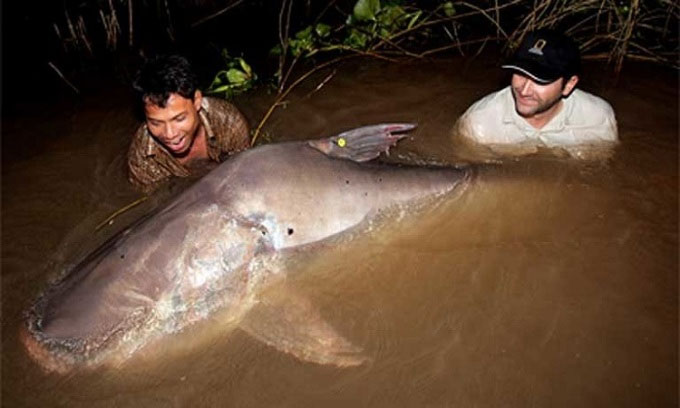The Nam Sang Dam project, along with many other new hydropower dams in Laos, could negatively impact the survival of giant fish species such as the Mekong giant catfish.
Historically, some of the largest freshwater fish species in the world swam throughout the Mekong River, passing through the city of Luang Prabang in Laos. The Mekong giant catfish, the giant barb, and many other colossal fish used to swim past Buddhist temples and traditional wooden houses on their journey to spawning grounds in the north. After decades of overfishing in the Mekong River, they are now rarely seen. Nevertheless, many scientists have found that as long as the Mekong River in southern China remains free from dam blockage, small-scale fishing and conservation efforts could help these critically endangered species recover.

Zeb Hogan releases a Mekong giant catfish that was tagged in 2007. (Photo: Zeb Hogan)
However, that hope seems to be fading as Laos plans to construct at least 10 new dams on the main branch of the Mekong River over the next decade. One of the first projects is Nam Sang, a large-scale hydropower plant being built upstream from Luang Prabang. The Laotian government has constructed dozens of dams on the Mekong’s tributaries, hoping that new dams like Nam Sang, which is expected to be completed in 2027, will generate income by selling electricity to neighboring countries, including Thailand.
“If these dam projects proceed, the section of the Mekong River that has been a habitat and spawning ground for some giant fish species will be divided into smaller segments,” said Zeb Hogan, a biologist specializing in fish at the University of Nevada, Reno, who has studied Mekong giant fish for over two decades. “For species that require free-flowing water to survive, this could be a death sentence.”
In addition to the Mekong giant catfish, dolphins, crocodiles, and many other large freshwater animals are also threatened by the new dams. Globally, there are over 3,400 large-scale hydropower projects in planning or construction, mostly concentrated in biodiversity-rich rivers in the tropics, according to recent research published in the journal Biological Conservation by Fengzhi He, a specialist at the Leibniz Institute of Freshwater Ecology and Inland Fisheries in Germany. The study indicates that dams significantly impact the largest animals living in rivers. If constructed, these projects could jeopardize the survival of many freshwater species.
“This is a pattern we have seen in many other tropical rivers such as the Amazon and Congo, but the Mekong is emblematic of this problem. The rapid development of hydropower will lead to the extinction risk of some of the most iconic animal species in the world.”
The population of large freshwater animals, which includes species averaging over 30 kg, ranks among the most endangered on Earth. Their global numbers have declined by nearly 90% since 1970, a rate that is twice as fast as the decline of terrestrial or marine vertebrates, according to a 2019 study published in Global Change Biology. Large fish species such as sturgeon, salmon, and Mekong giant catfish, particularly in the Northern Hemisphere, have experienced even sharper declines due to overfishing, pollution, and dam construction.
The Mekong River flows through six countries and is home to more large fish than any other river system in the world. However, among the largest species found here, nearly all are in extremely critical condition. For instance, Hogan has not seen a Mekong giant catfish since 2015. Conservation experts hope that new dams will be built following less harmful models, similar to two mega-hydropower dams currently operating on the main branch of the Mekong.
One project is the Don Sahong Dam, built where the Mekong River branches, providing fish with an alternative route around the dam. Meanwhile, Thailand’s Xayaburi Dam project has allocated over $300 million to help fish navigate the dam, including the installation of fish ladders.
Not only do hydropower dams obstruct fish movement, but they also alter the hydrological conditions that migratory fish rely on for feeding and spawning. The Mekong River is regulated by seasonal floods that can raise water levels by up to 12 meters during the rainy season. However, in recent years, the flood rhythm has been disrupted by regional droughts and by China holding back water from upstream dams, according to satellite data from the Stimson Center.
This data also indicates that over the past three years, water levels in the Mekong River system have reached historic lows. “For fish that have evolved to migrate at the onset of the flood cycle, altered flow can create a mismatch between the timing of fish migration and the ideal environmental conditions for their offspring,” said conservation ecologist Aaron Koning at the University of Nevada, Reno.


















































